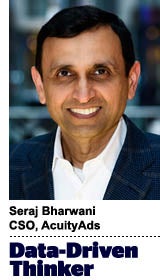“Data-Driven Thinking” is written by members of the media community and contains fresh ideas on the digital revolution in media.
Today’s column is written by Seraj Bharwani, Chief Strategy Officer at AcuityAds.
Since the advent of One-Click checkout, advertisers have realized that awareness, consideration and purchase can all happen in seconds for consumable products.
Thus, the rise of ecommerce marketplaces has forced a major shift in the design of the consumer journey to reduce friction and increase efficiency. But advertisers must develop different strategies depending on whether they’re messaging consumers via the open web, a social media platform or a major marketplace such as Amazon, Walmart or Target.
Here’s what savvy advertisers must consider.
Amazon, Walmart and Target can deliver high-velocity sales, but with limited margin and data
Consumers go to marketplaces to look for consumable products, compare prices and buy – though typically not big-ticket items. The top hundred fastest moving items on Amazon are all under $200.
A typical experience begins and ends in the marketplace with the user searching for product listings, competitive prices and reviews – followed by a beeline to the cart and checkout. The journey is clearly streamlined for frictionless purchase and delivery.
Competition, however, is intense among advertisers, and includes hundreds of third-party resellers and, assuming the shopper is on Amazon, the ecom giant’s own private-label products.
There is extreme pressure on profit margins, especially after accounting for promotions, discounts and varied service and transaction fees levied by Amazon. Brand-building experiences remain limited to Amazon’s pre-defined product and brand-store templates.
Even with Amazon Prime membership bringing millions of consumers monthly to the platform, advertisers’ ability to capture customer data remains severely limited, and these limitations are the same in other ecommerce marketplaces like Walmart and Target that claim ownership of customer relationships.
Social platforms remain restricted by community guidelines and limited to impulse purchases
Shoppable ads on social platforms integrate media, influencer content, community content and advertiser-facilitated merchandising to inspire purchases that might otherwise take longer or may never happen. The fact that the actual transaction and delivery is managed by the advertiser allows unique opportunities to initiate direct-to-customer relationships, helping expand the advertiser’s customer file for future repeat purchases and higher customer lifetime-value.
The challenge with social platforms is brand safety and accessibility of audiences across industries. These platforms are not accessible to advertisers in certain industries such as healthcare where over-the-counter drugs cannot be promoted.
Furthermore, shoppable media within social platforms confines users to brand-centric product catalogues or buy pages, which are suited for purchases under the $150 mark, where comparisons, reviews and further consideration is less of a factor.
The open web can compress big-ticket purchases, but lacks omnichannel tools
Few brands have mastered the challenges of delivering frictionless commerce for high involvement, considered purchases such as home improvement, automobiles, and financial products.
Shortening the consumer journey for products that today can take weeks or even months can be of tremendous benefit to the advertisers. Brands that are making headway generally have a combination of critical components for the digital consumer journey. These include a strong DTC presence, customer data tracking and CRM systems, seamless integration with internal and partner content, tools, products, and fulfillment services.
All of these tools create a unified path that aligns organically with the consumer’s decision-making process. The open web provides a network of relevant touchpoints for interactions with consumers when they are in the mindset for considered purchases.
Yet advertisers still don’t have full control over and visibility into the journey stages across the open web of publishers and channels.
While advertising planning is guided by extensive research and elaborate journey maps, the bridge to media execution is unfortunately achieved through archaic line-item interfaces, which bear little resemblance to the original plan and offer minimal insights.
The road map to modern consumer journey planning
As is my experience with a variety of clients, the promise of frictionless commerce has brought advertisers like bees to pollen in the direction of marketplaces and/or social media.
Unfortunately, few consider the nuances that distinguish the marketplaces, platforms and the open web. And these nuances play critical roles in facilitating the consumer journey and creating a “frictionless” journey or one with less friction.
While there is not currently a one-size-fits-all model for advertisers looking to enhance and enable purchasing and relationship building with audiences online, there is certainly a road map that can be used for navigation.
Follow AcuityAds (@AcuityAds) and AdExchanger (@adexchanger) on Twitter.












